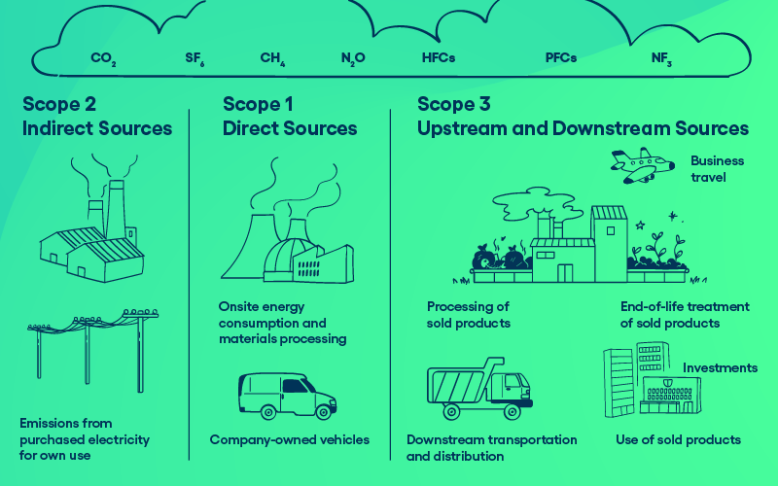How to Calculate Your Business’s Carbon Footprint
Whether you know it or not, your business has an impact on the environment. And it’s not a small one – many companies contribute significantly to climate change, air pollution, and other forms of environmental destruction.
Calculating the “carbon footprint” of your company can help you figure out just how much your business contributes. This article will walk you through the steps of calculating your carbon footprint in a simple and informative way. But before you can learn how to calculate your carbon footprint, let's first talk about what it actually means.
What is a carbon footprint?
A carbon footprint is a measure of the amount of carbon dioxide, greenhouse gases, or other carbon compounds emitted into the atmosphere by activities related to an organization or business. Many activities can serve as the source of these emissions. They could come from direct sources such as onsite energy consumption and fuel used by company-owned vehicles. Or they could come from more indirect and downstream sources like emissions from purchased electricity or transportation and distribution.
Determining carbon footprints helps organizations assess and compare the environmental impact of their presence. By measuring and understanding the elements that make up this output, these organizations can better identify areas to reduce emissions, reducing costs and utlimately furthering their sustainability initiatives.

Why is calculating carbon footprint important for businesses?
Calculating a carbon footprint has become an increasingly important factor for businesses in the last few decades as businesses continue to create more and more emissions through their activities.
According to the EPA, it is estimated that human activities are responsible for nearly all of the increase in greenhouse gases (GHG) seen over the last 150 years. Of these activities, fossil fuel burning for electricity, heat, and transportation have proven to be the largest sources of GHG emissions in the United States.
Businesses thus have a critical social responsibility to assess and analyze their carbon footprint in order to help reduce these emissions and minimize dramatic environmental changes being caused by climate change. Here are a few reasons why organizations can benefit by paying closer attention to their carbon footprint.
1. It's the first real step toward carbon reduction
Calculating a carbon footprint is an essential first step for organizations to make meaningful change in reducing their impact on the environment. Once businesses have identified and quantified the sources of their carbon footprint -- whether through direct or indirect means -- they can begin to set achievable targets and devise strategies for reducing the environmental impact of their activities.
Any organization that wants to take stock of their energy and sustainability habits should start by carrying out a carbon footprint assessment. From there, you can take real steps toward lowering your carbon footprint. You can learn more in our recent blog post 10 Simple Ways to Reduce Your Business’s Carbon Footprint.
2. Transparent business is good business
As businesses become increasingly aware of the negative impacts of climate change, transparency in sustainability efforts is more important than ever before. By sharing specific details on existing and ongoing mitigation measures, organizations are able to build trust with their customers and with investors.
A recent survey shows that 94% of consumers are likely to favor a brand that is completely transparent about its sustainability efforts. Companies now have the opportunity to not only demonstrate their commitment towards minimizing carbon footprint but actively engage stakeholders in their environmental initiatives.
3. It's good for your bottom line
From a financial standpoint, reducing your carbon footprint can have significant impacts on your bottom line by cutting costs and boosting efficiency. Energy-efficient systems like LED lighting and advanced HVAC solutions lower utility bills, while practices like recycling and repurposing materials reduce costs related to waste.
Process improvements driven by sustainability, like lean manufacturing and automated energy monitoring, can also help streamline operations by finding and eliminating inefficiencies in your workflows.
How to calculate your carbon footprint as a business
Understanding your business’s carbon footprint is a vital step toward achieving sustainability goals like carbon neutrality or net zero. By quantifying and analyzing your emissions, you can identify opportunities to reduce waste, save costs, and contribute positively to the environment.
Step 1: Identify the sources of your carbon emissions
The first step in calculating your business's carbon footprint is identifying where emissions come from. Focus on major sources like transportation, energy use in production, and vehicle emissions. By listing these activities—especially those involving fossil fuels—you’ll gain a clearer picture of your footprint. This initial step helps you understand your biggest contributors to CO2, laying the groundwork for reducing emissions and achieving sustainability goals.
Step 2: Collect quantitative emissions data
Next, gather the data needed to calculate your emissions. This includes tracking energy consumption, transport miles, and waste generation. While this process can be time-consuming, tools like Energy Manager simplify data collection by automating energy usage monitoring. Keeping your data accurate and regularly updated will ensure a more reliable carbon footprint estimate, ultimately making your sustainability efforts more efficient.
Step 3: Convert the data and calculate your footprint
To calculate your carbon footprint, convert your data into emission values using an emissions factor (GHG emissions = Data x Emission Factor). Use trusted sources like the EPA for accurate emissions factors, then sum the values from each activity to get your total footprint. Though this calculation can be complex, technology can automate much of the process, saving you time and effort.
Step 4: Standardize your process
Once you’ve calculated your footprint, standardize the process for consistency in future calculations. This allows you to use the same inputs each year and easily spot discrepancies. By establishing a clear process now, you can save valuable time in the future and ensure accurate comparisons for ongoing sustainability improvements.
How to use your carbon footprint calculation
Calculating your carbon footprint is a critical step toward developing effective carbon reduction initiatives. This process provides businesses with the information needed to identify opportunities for emissions reduction, set actionable carbon targets, and share emissions data with stakeholders. By understanding how each area of the business contributes to emissions, companies can develop targeted strategies that maximize the impact of their sustainability efforts.
Once you’ve calculated your carbon footprint, you can set realistic, long-term reduction goals based on data, helping track progress and refine your strategies over time. Regular assessments ensure that plans align with evolving objectives and demonstrate measurable results. Additionally, carbon footprint data enables businesses to disclose their environmental impact transparently to stakeholders.
By leveraging carbon footprint calculations, organizations can not only reduce their environmental impact but also unlock operational efficiencies, better meet regulatory requirements, and build more trust with customers and partners. Transparency in emissions data strengthens credibility, while targeted reduction strategies can lead to cost savings and competitive advantages. Ultimately, understanding and managing your carbon footprint is an investment in both your company’s future and the health of the planet.
Things to consider when calculating your carbon footprint
No matter how detailed your carbon footprint analysis may be, it's impossible to benefit from your calculation without taking steps to make change. Ultimately, being mindful of these aspects can help ensure that your efforts are both meaningful and effective when it comes to reducing your environmental impact.
Do you need to follow a reporting framework?
When calculating your carbon footprint, it’s essential to determine if a specific reporting framework is necessary. A reporting framework provides structure, guiding how emissions data are categorized and reported, and can simplify the calculation process by establishing clear parameters.
Many businesses opt for widely recognized frameworks like CDP or ENERGY STAR. However, geographic-specific regulations (such as NYC’s Local Law 97) or industry benchmarks (like GRESB for Commercial Real Estate) may offer more tailored guidelines. Choosing the right framework ensures your reporting aligns with legal requirements and industry standards, enhancing the credibility and utility of your emissions data.
Research your options thoroughly to select the framework that best suits your goals and operational needs. A well-chosen framework not only simplifies reporting but also supports a reliable and efficient sustainability strategy.
How can you leverage your findings?
Calculating your carbon footprint is just the first step—it’s what you do with that data that truly matters. Understanding your environmental impact allows you to create actionable plans to reduce emissions and work toward sustainability goals.
Simply having an estimate of your carbon output, however, isn’t enough. Without a strategic approach, businesses miss opportunities to make meaningful reductions. A focused plan enables organizations to turn calculations into measurable progress, achieving cost savings, improved efficiency, and environmental benefits.
Your carbon footprint calculation is most valuable when it serves as a foundation for tangible action. By tracking, measuring, and refining your efforts, you can set your business on a path to long-term sustainability.
Simplify carbon footprint calculations and reporting with Brightly Software
As the worldwide focus on climate change increases, it’s more important than ever for businesses to know and track their carbon footprint.
Brightly Software's ESG solutions can help you make smart choices that positively impact both the environment and your bottom line. With user-friendly interfaces, automated calculations, abundant data insights and customizable reporting, Brightly can help transform how your business monitors and manages its carbon footprint. Learn more about solutions Stream™ and Energy Manager™.



